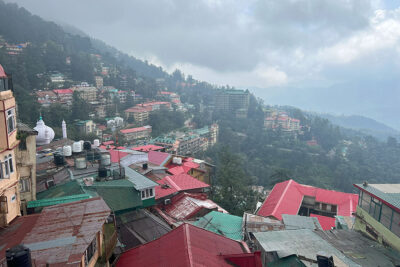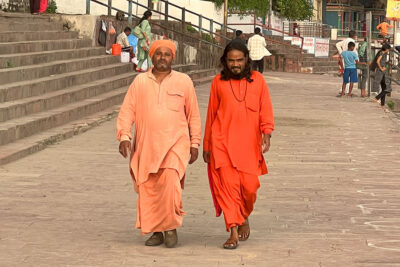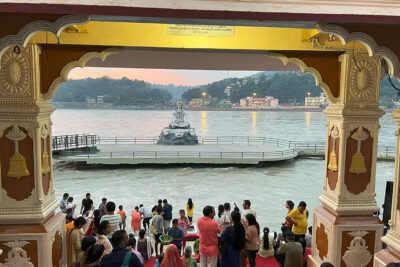Yoga, meditation and ayurveda: a mistic experience in Himachal Pradesh
15 days
This journey is conceived as a gentle, yet profound, passage through cultural, mystical and sensory essence of India — a retreat designed to harmonize body, mind, and soul in perfect balance. Over the course of two transformative weeks, you will experience India’s ancient wisdom expressed through three interwoven dimensions: yoga, meditation, and ayurveda — each anchored in some of the most sacred and inspiring corners of the country.
The first segment of this journey begins on the banks of the sacred Ganges in Rishikesh, the world’s yoga capital and a timeless place of pilgrimage for seekers of inner peace. Here you’ll wake with the sun to practice Hatha yoga and pranayama, bringing breath and body into union amidst the sound of flowing waters and temple bells. You’ll join prayer ceremonies at dawn, feel the power of silence while meditating in a Himalayan cave, and walk through age-old ashrams that carry centuries of devotion within their walls. As evening falls, you’ll witness the hypnotic beauty of the Ganga Aarti, where fire and chanting transform the riverbank into a luminous offering of faith. These days are a true immersion into the rhythm of spiritual life, offering space for reflection and renewal.
The journey then carries you north to the Himalayan foothills of McLeod Ganj, home to the Tibetan community in exile and the beating heart of Tibetan Buddhism in India. Here the focus gently shifts from the discipline of yoga to the contemplative power of meditation and mindfulness. Each moment is imbued with spiritual depth: walking the kora (circumambulation) around the Dalai Lama’s temple, hanging colorful prayer flags on windswept hillsides, sitting quietly in forested paths near ancient monasteries, or sharing stories with monks and artisans who keep their culture alive in exile. You’ll visit orphanages and libraries, witness centuries-old rituals, and even have the chance to consult a traditional Tibetan healer — discovering a community where resilience and compassion shine through in every gesture.
In the final section the journey slows to an even deeper pace as you reach the serene lakeside sanctuary of Tattapani — a place dedicated to the healing of the body and the quieting of the mind. Here, surrounded by lush hills and the gentle flow of the Satluj River, you’ll surrender to deep relaxation. You can soak in natural sulphur hot springs revered for their restorative properties, receive personalized Ayurvedic treatments to realign body and spirit, and take part in age-old fire rituals and astrology readings that illuminate your personal journey. In the evenings, you’ll share music, dance, and traditional meals with local families, connecting with the warmth and simplicity of Himalayan life in its most authentic form. These days are designed as a complete regeneration of energy, an opportunity to re-center and reconnect with yourself.
Throughout the itinerary, moments of discovery and beauty — from the shimmering Golden Temple of Amritsar to the colonial charm of Shimla’s hill station — enrich the experience, adding layers of culture and history to your retreat.
More than a trip, this is an intentional journey: an invitation to slow down, breathe with awareness, and let the wisdom of India — carried in its rivers, mountains, prayers, and people — gently transform you. You will return home lighter in body, clearer in mind, and fuller in spirit, having experienced not just India’s sights, but its soul.
JOURNEY OVERVIEW AND PROGRAM DETAILS
DAY 1: ARRIVAL IN DELHI
Upon arrival at Indira Gandhi International Airport, you will be welcomed by your representative and transferred to the hotel for some rest. Later you will begin your discovery of Delhi, India’s vibrant capital steeped in history and spirituality.
Start your morning exploring the fascinating lanes of Old Delhi, where centuries of culture come alive in the bustling bazaars and ancient monuments. Admire the grandeur of the Red Fort (from outside), a UNESCO World Heritage site built in 1639 by Mughal Emperor Shah Jahan, and visit the impressive Jama Masjid, one of the largest mosques in India, where a rare copy of the Quran written on deer skin is preserved. Continue with a stroll through the lively Chawri Bazar, one of the city’s oldest and busiest markets, absorbing its authentic atmosphere.
As evening approaches, experience a memorable visit to the ISKCON Temple, one of the largest Vaishnava temples in India dedicated to Lord Krishna and Radha. Here you can witness the enchanting Usthapana Arati, the traditional ceremony of lights, as chants and hymns fill the air. Conclude your day with a pure vegetarian dinner at Govinda’s, the temple’s restaurant, where the meal is served as prasadam — blessed food, offered to Lord Krishna and shared in a spirit of devotion. After dinner, transfer to your hotel.
Overnight in Delhi (D)
DAY 2: VISIT THE HOLY CITY OF HARIDWAR
Delhi – Haridwar – Rishikesh
After breakfast, transfer to Rishikesh (approximately a 5-hour drive). Known as “the yoga capital of India,” Rishikesh has been a place where sages and gurus have perfected the practices of meditation and yoga for centuries. On the way, stop to visit the sacred city of Haridwar. The sight of the Ganges River descending from the Himalayan foothills is truly spectacular. Here, the Ganges leaves the mountains and begins its journey across the plains, giving the city its unique spiritual significance.
The tour includes a visit to Chandi Devi Temple, perched atop Neel Parvat and offering panoramic views of the city. The temple is accessible by a pleasant 3 km walk from Chandi Ghat. You will also visit Maya Devi Temple, located east of Har-Ki-Pauri, as well as Bhimgoda Dam and Pawan Dham, famous for its glass-decorated Hanuman Mandir.
Arrive in Rishikesh and check in at the selected retreat.
Overnight in Rishikesh (B)
DAY 3: EXPLORE RISHIKESH
Rishikesh
Early in the morning, before breakfast, enjoy a Hatha yoga and pranayama class. The term yoga comes from the Sanskrit word Yuj, meaning “to join, unite, or direct.” Practicing yoga helps you gain control over the forces of body, mind, and soul — a powerful way to discipline the intellect, emotions, and will, while approaching life with serenity in all its aspects. After breakfast, join the morning prayer and fire ceremony (Guru pooja and Shanti havan) at the temple.
Later, embark on a sightseeing tour of Rishikesh, beginning with a visit to the iconic Lakshman Jhoola, a suspension bridge crossing the Ganges. A pleasant 2 km walk brings you to Sivanand Jhoola, also known as Ram Jhoola. Beyond this bridge lies the Swargashram area, a peaceful enclave filled with ashrams. The narrow path that runs alongside the river is lined with shops and restaurants on one side and ashrams on the other — an area renowned for its quiet atmosphere and closeness to the Ganges.
In the evening, you will attend the enchanting Ganga Aarti at Parmarth Niketan Rishikesh, one of the most renowned spots to witness this beautiful ceremony performed at sunset.
Overnight in Rishikesh (B)
DAY 4: MEDITATE IN A CAVE
Rishikesh – Vashishta Gufa – Rishikesh
Early in the morning, before breakfast, enjoy a Hatha yoga and pranayama class. After breakfast, join the morning prayer and fire ceremony (Guru pooja and Shanti havan) at the temple.
Later, visit the famous Beatles Ashram. A trip to Rishikesh would not be complete without exploring the fascinating remains of the mystical Maharishi Mahesh Yogi Ashram, more popularly known as the “Beatles Ashram” after the band’s legendary stay here in the late 1960s. You will stroll through the beautifully preserved ashram grounds and discover the peaceful spaces where The Beatles meditated and composed some of their most iconic songs. Walk among the meditation cells, visit the Beatles Cathedral Gallery, and immerse yourself in the vibrant murals and artwork that adorn the walls of the ashram.
In the afternoon, continue to Vashishta Gufa, a serene and spiritual site on the banks of the Ganges, ideal for meditation and yoga. This ancient cave is said to have been the meditation retreat of the sage Vashishta for many years. Inside the cave, a small diva lamp illuminates a Shiva lingam and the quiet presence of those meditating. Outside, the lush greenery and the vast, winding Ganges create a breathtaking landscape — perfect for photography and quiet contemplation.
If you wish, you may also take some time on the quiet sandy beach along the river, enjoying the refreshing and purifying waters of the Ganga. Later, return to Rishikesh.
Overnight in Rishikesh (B, D)
DAY 5: TRANSFER TO CHANDIGARH & CITY VISIT
Rishikesh – Chandigarh
After an early breakfast, depart by road for Chandigarh, a journey of approximately 5 hours through the scenic foothills of the Himalayas and into the fertile plains of Punjab. Chandigarh is renowned as India’s first planned city and a modernist masterpiece, designed by the visionary architect Le Corbusier in the 1950s. Today, its Capitol Complex is recognized as a UNESCO World Heritage Site, a testament to its unique contribution to contemporary urban design.
On arrival, enjoy a guided tour of the city’s highlights. Visit the extraordinary Rock Garden, an imaginative maze of sculptures and courtyards created entirely from recycled materials — a fascinating testament to creativity and sustainability. Stroll along the tranquil promenade of Sukhna Lake, where locals gather at sunset, and admire the harmonious blend of geometry, open green spaces, and modernist architecture that make Chandigarh so distinctive.
Overnight in Chandigarh (B)
DAY 6: TRANSFER TO AMRITSAR & WAGAH BORDER CEREMONY
Chandigarh – Amritsar
After breakfast, depart by road for Amritsar, a journey of approximately 4–5 hours through the heart of Punjab’s fertile plains. Upon arrival, check into your hotel and take some time to rest.
Amritsar is one of India’s most ancient and fascinating cities. As the spiritual and cultural center of Sikhism, it holds deep significance for the Sikh community of over 27 million people worldwide. At its heart stands the breathtaking Golden Temple, one of India’s most iconic and revered landmarks, shining like a jewel in the middle of its sacred pool.
In the late afternoon, head towards the Wagah Border, the symbolic frontier between India and Pakistan, to witness the famous flag-lowering ceremony. This daily ritual, known as the Beating Retreat Ceremony, is a unique display of synchronized military pageantry and national pride performed by soldiers of both nations. The atmosphere is electric — with patriotic songs, cheering crowds, and soldiers marching in perfect unison before the flags of both countries are lowered for the night. The ceremony is at once solemn and theatrical, offering a glimpse into the complex relationship between the two neighbors.
After the ceremony, return to your hotel for dinner and an evening at leisure.
Overnight in Amritsar (B)
DAY 7: DISCOVER THE SPIRITUAL HERITAGE OF AMRITSAR
Amritsar
Today is dedicated to exploring the rich spiritual and cultural heritage of Amritsar’s old city.
Your morning begins with a visit to the Silver Temple (Sri Durgiana Mandir), dedicated to the Hindu goddess Durga. Its shimmering silver doors and peaceful atmosphere make it a remarkable site of devotion. You’ll then continue to the Mata Lal Devi Temple, an extraordinary labyrinthine Hindu shrine that commemorates Lal Devi, a revered 20th-century female saint. Its colorful interiors and winding passages create a truly unique spiritual experience.
Next, enjoy a leisurely walk through the bustling lanes of the old city, soaking in the vibrant daily life of Amritsar, where the Sikh majority and Hindu minority coexist in a rich tapestry of traditions.
Later, visit the Akal Takht, or “Throne of the Timeless One,” an integral part of the Golden Temple complex and a powerful symbol of Sikh political sovereignty and spiritual authority.
After sunset, experience the profound atmosphere of the Golden Temple (Harmandir Sahib) — the holiest Gurdwara and most important pilgrimage site for millions of Sikhs worldwide. As dusk falls and the temple glows in golden light, you will witness the moving Palki Sahib ceremony, during which the Guru Granth Sahib, the Sikh holy scripture, is reverently carried to its resting place for the night. This deeply spiritual ritual embodies the connection between daily devotion and timeless faith.
Overnight in Amritsar (B)
DAY 8: TRANSFER TO DHARAMSHALA
Amritsar – McLeod Ganj
After breakfast, depart for Dharamshala, in the Indian state of Himachal Pradesh. The journey takes you through picturesque landscapes of fir, oak, and pine forests, surrounded on three sides by majestic snow-capped peaks.
Since 1960, when it became the temporary residence of His Holiness the Dalai Lama, Dharamshala has gained international fame as “Little Lhasa in India.” Just 9 km above Dharamshala, at an altitude of 2,082 meters, lies McLeod Ganj, the official seat of the Tibetan government-in-exile since 1959. Here you will find vibrant Buddhist monasteries, thousands of Tibetan refugees, and pilgrims who come from around the world to pay homage and seek spiritual inspiration. To conclude your day, you will have the rare opportunity for a private consultation (on request) with a Tibetan Amchi, a traditional doctor who practices holistic healing rooted in the balance of internal elements and natural remedies.
Overnight in McLeod Ganj (B)
DAY 9: VISIT TO THE DALAI LAMA’S RESIDENCE AND TIBETAN CULTURAL HERITAGE
McLeod Ganj
After breakfast, set out for a walking tour of McLeod Ganj, beginning with the circumambulation (Kora) around the Dalai Lama’s residence and a visit to the Tsuglag Khang, the main temple of His Holiness. Here, you will take part in the symbolic offering of prayer flags, which will be hung on the hill of Lahagyalri near the temple, accompanied by traditional rituals and prayers.
Continue to explore McLeod Ganj’s lively local market, where you can browse and purchase beautifully crafted Tibetan handicrafts. Your guide will then accompany you to St. John in the Wilderness Church, a striking Gothic structure built in 1852, which also houses the memorial of British Viceroy Lord Elgin and an atmospheric old cemetery.
In the afternoon, enjoy a peaceful stroll by Dal Lake, a scenic spot framed by ancient Deodar forests and home to a small Durveshwar Mahadev Temple, offering a serene atmosphere for reflection.
After a delicious lunch at a local restaurant, visit the Tibetan Children’s Villages, a non-profit community dedicated to the care and education of orphaned and refugee Tibetan children. Here you will gain a deeper understanding of Tibetan culture, resilience, and the preservation of Buddhist traditions in exile.
Later in the day, return to the monastery for quiet reflection, followed by visits to the Tibetan Medical and Astrology Museum and the Library of Tibetan Works and Archives, two vital institutions preserving centuries of knowledge.
Overnight in McLeod Ganj (B)
DAY 10: DISCOVER THE ART & SPIRIT OF TIBET AT NORBULINGKA
McLeod Ganj – Dharamshala
After breakfast, transfer to the Norbulingka Institute, a true sanctuary of Tibetan art and culture, nestled in lush gardens with flowing streams and traditional architecture. Founded under the patronage of His Holiness the Dalai Lama, Norbulingka is dedicated to preserving Tibetan heritage through living traditions.
You will check in at the Norling Guest House, the institute’s serene boutique accommodation, surrounded by nature and prayer flags — a perfect place to disconnect and recharge.
Spend the day exploring the vibrant workshops where artisans keep alive the ancient crafts of Thangka painting, wood carving, appliqué, and metal sculpture. Here, you’ll experience first-hand what it means to “create with mindfulness,” guided by masters who have perfected their craft.
Take part in a Thangka painting session, an inspiring hands-on experience where you learn the symbolism of this sacred art and paint your own small motif to take home.
Visit the enchanting Losel Doll Museum, which showcases traditional Tibetan life through over 150 hand-crafted dolls in regional costumes and admire the breathtaking murals and golden statues inside the Deden Tsuglagkhang Temple, where you can join a short, guided meditation in the peaceful shrine hall.
There’s also time to relax in the gardens, browse the boutique for authentic crafts and gifts, and enjoy fresh vegetarian cuisine in the café.
Overnight at Dharamshala (B, L, D)
DAY 11: TRANSFER TO TATTAPANI
McLeod Ganj – Harnora – Tattapani
After breakfast, depart from McLeod Ganj heading south through the scenic Kangra Valley, with its rolling hills and timeless rural landscapes. Along the way, stop at the sacred Jawalamukhi Temple, one of India’s most revered Shakti Peethas, where the eternal natural flames are worshipped as a manifestation of the goddess. Take time to experience the spiritual energy of this unique shrine and join a short ritual if you wish.
Continue the drive at a relaxed pace, with a stop en route for lunch, before reaching the Harnora dam, where a private boat awaits you. From here, embark on a serene two-hour cruise on the Satluj River, sailing through verdant hills and calm waters — a peaceful and memorable way to approach your final destination.
Arrive directly at your lakeside retreat in Tattapani, an oasis dedicated to the regeneration of body and mind. Here you can enjoy Ayurvedic therapies, yoga, and the soothing natural sulphur springs — all surrounded by pristine nature. The perfect setting to unwind and reconnect.
Overnight in Tattapani (B, D)
DAY 12: WELLNESS & DISCOVERIES IN TATTAPANI
Tattapani
Your first full day in Tattapani is dedicated to slowing down and embracing the healing atmosphere of this Himalayan haven.
After breakfast overlooking the water, take time to relax and soak in the natural sulphur hot springs, long renowned for their therapeutic properties. You may choose to enhance your experience with an Ayurvedic massage or personalised treatment designed to restore balance and energy under the guidance of expert therapists.
Throughout the day, a range of enriching activities is available for those who wish to explore further. You can take a leisurely walk through the village or hike into the surrounding hills for panoramic views of the river valley. Visit small local temples nestled in the greenery, or enjoy a quiet boat ride on the tranquil lake.
For a deeper cultural connection, opt for a consultation with a Jyotish (Vedic astrologer), take part in a Hawan fire ceremony or a Tula Dhan Saturn Puja, and discover more about India’s ancient wisdom through a spice workshop or an introduction to Ayurveda session.
As the day comes to a close, you can join the evocative riverside Aarti fire ceremony at sunset, or enjoy a traditional dinner hosted by a local family — an authentic way to experience the region’s warm hospitality.
Overnight in Tattapani (B, L, D)
DAY 13 – SPIRITUAL RITUALS & LOCAL TRADITIONS IN TATTAPANI
Tattapani
Your second day in Tattapani focuses on discovering the spiritual depth and living traditions of this Himalayan retreat. After a relaxed breakfast by the lake, set out on a guided walk through the surrounding villages, meeting locals and getting a glimpse of daily life in the hills. The stroll takes you to small, centuries-old temples nestled among the trees, where you can pause and feel the quiet energy of these sacred spots.
In the late morning, take part in a Hawan fire ceremony, an ancient Vedic ritual performed to purify the environment and invoke blessings — a profound way to connect with India’s spiritual heritage. If you wish, you can also participate in a Tula Dhan Saturn Puja, a unique ritual of offering that symbolizes balance and renewal. After lunch, enjoy some free time to rest or book a consultation with a Jyotish (Vedic astrologer), who will interpret your birth chart and share insights into your personal cosmic alignment — a fascinating and intimate experience. Later in the afternoon, join an engaging spice workshop, learning about the healing and culinary uses of traditional Indian spices and even blending your own masala to take home.
As evening falls, gather on the riverbank to witness the evocative Aarti fire ceremony, with flickering lamps, chants, and the serene waters reflecting the glow of devotion. To close your day in style, enjoy a festive folkloric evening with music and dance, or share a heartwarming dinner with a local family, tasting authentic recipes and stories of the region. A perfect balance of introspection, learning, and celebration.
Overnight in Tattapani (B, L, D)
DAY 14 – VISIT SHIMLA
Tattapani – Shimla
After a final serene morning in Tattapani, enjoy the soothing hot springs or simply relax amidst the peaceful surroundings of your lakeside retreat. Take your time to soak in the last moments of this wellness haven before departing late in the morning for Shimla, the former summer capital of British India.
Arrive in Shimla in the afternoon and check into your hotel. Later, enjoy a leisurely walk along the famous Mall Road, lined with charming colonial buildings, lively shops, and cafés. Admire the unique blend of British heritage and Himalayan charm that has earned Shimla its title as the “Queen of the Hills.” Take in the cool mountain air and soak up the vibrant yet relaxed atmosphere of this historic hill station.
Dinner and overnight stay in Shimla.
Overnight in Shimla (B, D)
DAY 15 – SHIMLA TO CHANDIGARH & DEPARTURE
Shimla – Chandigarh
After breakfast in Shimla, depart by road towards Chandigarh. On arrival at Chandigarh airport, you will be assisted with the check-in procedures for your international flight.
Your journey ends here, carrying with you the memories of an experience rich in culture, spirituality, and the timeless beauty of India.
activities
- Wander through the narrow lanes and Mughal landmarks of Old Delhi, with its bustling bazaars, Jama Masjid, Raj Ghat, and the serene Lotus Temple.
- Experience the spiritual energy of ISKCON Temple at sunset and enjoy a traditional prasadamdinner in its sacred atmosphere.
- Visit the holy cities of Haridwar and Rishikesh, joining pilgrims at riverside ghats, ancient temples, and the enchanting Ganga Aarti ceremony at dusk.
- Meditate in the mystical Vashishta cave, practice yoga and pranayama at sunrise, and explore the ashrams and quiet riverside paths of Rishikesh.
- Witness the powerful symbolism of the Wagah Border ceremony and the sublime Golden Temple of Amritsar, glowing under the evening lights.
- Explore the labyrinthine temples, colorful markets, and spiritual sites of Amritsar’s old city, and experience the moving Palki Sahib ritual at Harmandir Sahib.
- Immerse yourself in Tibetan culture in McLeod Ganj, hanging prayer flags, visiting monasteries, and learning about exile life through crafts, rituals, and encounters.
- Create your own Thangka motif at Norbulingka Institute, and admire the peaceful gardens, golden temples, and artisans at work in this sanctuary of Tibetan art.
- Cruise the Satluj River on a private boat to arrive at your lakeside retreat in Tattapani, surrounded by hills and pristine nature.
- Unwind in Tattapani’s natural sulphur hot springs and indulge in personalized Ayurvedic therapies and massages to restore mind, body, and spirit.
- Take part in ancient spiritual rituals: Hawan fire ceremony, Tula Dhan Saturn Puja, riverside Aarti, and a Jyotish (Vedic astrology) consultation.
- Learn about India’s culinary and healing traditions through an interactive spice workshop and an introduction to Ayurveda.
- Connect with local life through guided walks to villages and temples, a home-cooked family dinner, and a lively evening of folk music and dance.
- Stroll along Shimla’s charming Mall Road, soaking up its colonial-era atmosphere and vibrant Himalayan hill-station charm before your departure.
SOCIAL AND ENVIRONMENTAL IMPACT
This journey has been thoughtfully crafted to create meaningful benefits for local communities, cultural traditions, and the natural environments of northern India and the Himalayan foothills, in line with the principles of responsible and ethical tourism. Whenever possible, accommodations and services are provided by locally owned heritage properties, community-run guesthouses, and eco-friendly retreats committed to social and environmental sustainability.
A distinctive aspect of this itinerary is the respectful engagement with diverse communities — from the Sikh custodians of Amritsar’s Golden Temple to Tibetan exiles preserving their culture in Dharamshala and Norbulingka, and the hill villagers of Himachal Pradesh. Encounters are carefully arranged to protect dignity and foster authentic cultural exchange: whether participating in Tibetan prayer rituals, hanging prayer flags at Lahagyalri, consulting a Jyotish (Vedic astrologer), or sharing an intimate home-cooked dinner in a Himalayan village, each experience supports the local hosts and helps sustain traditions often under threat from modern pressures.
By visiting places such as McLeod Ganj, the Norbulingka Institute, and the Tibetan Children’s Villages, guests contribute directly to the preservation of Tibetan heritage and to the education and welfare of refugee children. Artisan workshops at Norbulingka, Thangka painting sessions, and spice and Ayurveda classes in Tattapani provide income and recognition for craftspeople and healers who carry forward India’s intangible heritage.
The itinerary also directs tourism revenue to lesser-visited rural areas, such as Tattapani and the surrounding Satluj valley, where wellness tourism supports livelihoods through Ayurveda practitioners, boatmen, and small-scale farmers. These interactions encourage the transmission of local knowledge and reinforce cultural pride among younger generations.
From an environmental perspective, the journey emphasizes low-impact practices, using local resources and minimizing footprint by staying in properties with eco-conscious policies and traveling at a measured pace. Visits to sacred natural sites — like Dal Lake, Vashishta Gufa, the hot sulphur springs, and the riverbank Aarti ceremonies — are designed to foster awareness of water and forest ecosystems and the delicate balance between spiritual use and conservation.
By choosing this itinerary, travellers actively support the survival of living cultures, the well-being of communities in marginal regions, and the stewardship of fragile Himalayan ecosystems — helping to make tourism a force for good, rooted in respect and sustainability.
TIPS BEFORE DEPARTURE
A mindful and rewarding journey through India’s spiritual and cultural heartlands requires a willingness to adapt to local rhythms, traditions, and environments. We invite you to embrace this trip with an open mind and heart, ready to experience diverse spiritual practices, Himalayan village life, and Tibetan exile culture without preconceived notions or Western expectations. Patience, curiosity, and respect are key to unlocking the depth and authenticity of the places and communities you will encounter.
This itinerary includes stays in remote hill towns and villages, where infrastructure can be basic and comforts modest. Accommodations have been chosen for their cultural significance and eco-conscious approach, which may not align with standard luxury norms. Occasional power cuts, simple amenities, and long journeys on winding mountain roads are part of the authentic experience.
Weather in the Himalayas and northern plains can vary greatly depending on altitude and season. Days may be warm, while evenings and early mornings can be cool or even chilly, especially in Shimla and Dharamshala. We recommend packing layered clothing, a warm sweater or jacket, a light raincoat, sturdy walking shoes, insect repellent, and any essential medications. A refillable water bottle, flashlight or headlamp, and a small daypack will also be useful throughout the journey.
Visits to temples, monasteries, and sacred sites require modest attire. Please avoid sleeveless tops, shorts, and tight clothing; lightweight scarves or shawls can be helpful. Always ask permission before taking photos of individuals, especially during rituals or in rural and Tibetan communities.
This itinerary is not designed for those seeking fast-paced sightseeing or high levels of comfort. It is best suited to travellers with a spirit of adventure, a basic level of fitness, and a deep respect for cultural differences and spiritual practices — qualities that will allow you to fully appreciate the beauty, serenity, and meaning of this unique experience.
HOTELS
Accommodation includes a selection of spiritual retreats, heritage-style guesthouses, boutique mountain hotels, and lakeside wellness resorts. All properties are chosen for their local character, peaceful atmosphere, and sensitivity to cultural and environmental context. Comfort levels may vary, especially in remote or rural areas, but each stay reflects the unique essence of its surroundings.
TRANSPORT
All transfers are arranged with private vehicles adapted to the diverse road and terrain conditions of the journey. In remote or mountainous areas, reliable off-road vehicles and experienced local drivers ensure safe and comfortable travel. Boat transfers and short scenic cruises are also included where appropriate, adding to the charm of the experience.
WHEN TO GO
The best time to travel is from Mid- September to October, when the Himalayan weather is clear and pleasant, with crisp mornings, mild days, and comfortable evenings. This period is ideal for visiting the spiritual sites, walking through villages and markets, and enjoying outdoor rituals and ceremonies in a serene atmosphere. Ayurvedic treatments and hot spring baths are especially rejuvenating in the cool mountain climate.
From march to June, temperatures rise, particularly in the lower plains, but the higher Himalayan regions remain accessible and pleasant. However, road travel can feel warmer and more tiring at this time.
The monsoon season, from July to September, brings heavy rainfall and can cause occasional road closures or travel delays in the hills. Many outdoor activities become less predictable, and visibility over the mountains is often reduced.




